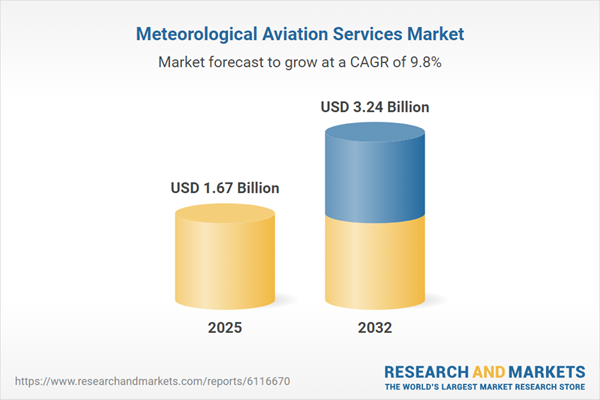Speak directly to the analyst to clarify any post sales queries you may have.
The Meteorological Aviation Services Market is evolving rapidly, as airlines, operators, and defense organizations increasingly prioritize sophisticated weather intelligence to strengthen safety, enable informed decision-making, and maintain resilient operations across global airspace.
Market Snapshot: Meteorological Aviation Services Market Overview
The Meteorological Aviation Services Market grew from USD 1.53 billion in 2024 to USD 1.67 billion in 2025. It is projected to expand at a CAGR of 9.77%, reaching USD 3.24 billion by 2032. Growth is fueled by demand for real-time, precise weather data and tailored forecasting capabilities, supporting safe flight operations and regulatory compliance for both manned and unmanned platforms.
Scope & Segmentation
This research delivers a comprehensive assessment across service categories, deployment modes, and end-use segments for aviation meteorological services, as well as a geographic breakdown and analysis of leading industry players.
- Service Type: Data and information, weather briefing and consultation, weather forecasting (long-term and short-term), weather observation
- Delivery Mode: API integrations, mobile applications, web-based platforms
- Forecasting Type: Aerodrome forecasts, area/route forecasts, special forecasts
- Platform: Ground stations, satellite systems
- End User: General aviation, military aviation, unmanned aerial vehicles
- Region: Americas (North America—United States, Canada, Mexico; Latin America—Brazil, Argentina, Chile, Colombia, Peru), Europe, Middle East & Africa (Europe—United Kingdom, Germany, France, Russia, Italy, Spain, Netherlands, Sweden, Poland, Switzerland; Middle East—United Arab Emirates, Saudi Arabia, Qatar, Turkey, Israel; Africa—South Africa, Nigeria, Egypt, Kenya), Asia-Pacific (China, India, Japan, Australia, South Korea, Indonesia, Thailand, Malaysia, Singapore, Taiwan)
- Key Companies: Vaisala Oyj, The Weather Company LLC, AccuWeather Inc., Baron Weather Inc., CoralComp Private Limited, CustomWeather Inc., DTN LLC, Honeywell International Inc., Jeppesen Sanderson Inc. (The Boeing Company), L3Harris Technologies Inc., Leidos Holdings Inc., Lockheed Martin Corporation, Lufthansa Systems GmbH & Co. KG, Raytheon Technologies Corporation, Thales Group, WDT Inc., Weathernews Inc.
Key Takeaways
- Integration of advanced weather intelligence with aviation workflows reduces operational risk, streamlines decision-making, and underpins real-time route optimization.
- Technological advancements in artificial intelligence, remote sensing, and high-resolution satellite imagery are driving improvements in predictive accuracy and hyperlocal forecasting for both commercial and unmanned flights.
- Regulatory modernization, including harmonized data standards and public-private collaboration, enables more seamless data sharing, system interoperability, and the development of end-to-end meteorological platforms.
- Service providers increasingly adopt modular cloud-based infrastructures and collaborate with aerospace OEMs, defense agencies, and regional partners to offer scalable weather solutions tailored for specific mission profiles.
- Regional variations in infrastructure maturity, regulatory regimes, and weather hazards shape demand for solutions ranging from basic mobile-compatible briefings to advanced integrated analytics and automation-ready platforms.
- Industry partnerships, mergers, and joint ventures drive capability expansion, particularly in the development of ground and upper-air observation networks and deployment of specialized sensor arrays.
Tariff Impact and Adaptive Responses
Recent tariff policy revisions in the United States have raised costs for imported equipment such as ground station hardware and onboard sensors. Providers are adjusting by sourcing more components domestically or near-shoring production, partnering with regional electronics manufacturers, and pursuing consortium-based purchases to limit volatility. These changes, while challenging, are driving greater investment in local infrastructure and supply chain agility. Strategic alliances to build regional data processing hubs further help mitigate the impact of cross-border trade disruptions and bolster service continuity.
Methodology & Data Sources
The findings in this report are based on a rigorous blend of primary interviews with industry leaders and operational experts, as well as extensive secondary data from white papers, technical documents, and regulatory disclosures. Quantitative analysis employs triangulation and advanced scenario modeling, with results peer-reviewed for accuracy and robustness.
Why This Report Matters
- Empowers senior decision-makers with actionable intelligence to prioritize technology investment and risk mitigation strategies within complex regulatory and operational environments.
- Offers detailed, segment-level insights and region-specific recommendations to tailor product development and market entry approaches.
- Supports airline and aviation service leaders in navigating emerging tariff impacts, cross-border service challenges, and evolving collaborative frameworks.
Conclusion
This report equips stakeholders with a comprehensive understanding of the meteorological aviation services market, highlighting essential drivers, strategic priorities, and innovation pathways. Armed with these insights, organizations can enhance operational safety, efficiency, and resilience in an increasingly complex global aviation sector.
Table of Contents
3. Executive Summary
4. Market Overview
7. Cumulative Impact of Artificial Intelligence 2025
Companies Mentioned
The companies profiled in this Meteorological Aviation Services market report include:- Vaisala Oyj
- The Weather Company, LLC
- AccuWeather, Inc.
- Baron Weather, Inc.
- CoralComp Private Limited
- CustomWeather, Inc.
- DTN, LLC
- Honeywell International Inc.
- Jeppesen Sanderson, Inc. by The Boeing Company
- L3Harris Technologies, Inc.
- Leidos Holdings, Inc.
- Lockheed Martin Corporation
- Lufthansa Systems GmbH & Co. KG
- Raytheon Technologies Corporation
- Thales Group
- WDT, Inc.
- Weathernews Inc.
Table Information
| Report Attribute | Details |
|---|---|
| No. of Pages | 191 |
| Published | October 2025 |
| Forecast Period | 2025 - 2032 |
| Estimated Market Value ( USD | $ 1.67 Billion |
| Forecasted Market Value ( USD | $ 3.24 Billion |
| Compound Annual Growth Rate | 9.7% |
| Regions Covered | Global |
| No. of Companies Mentioned | 18 |









